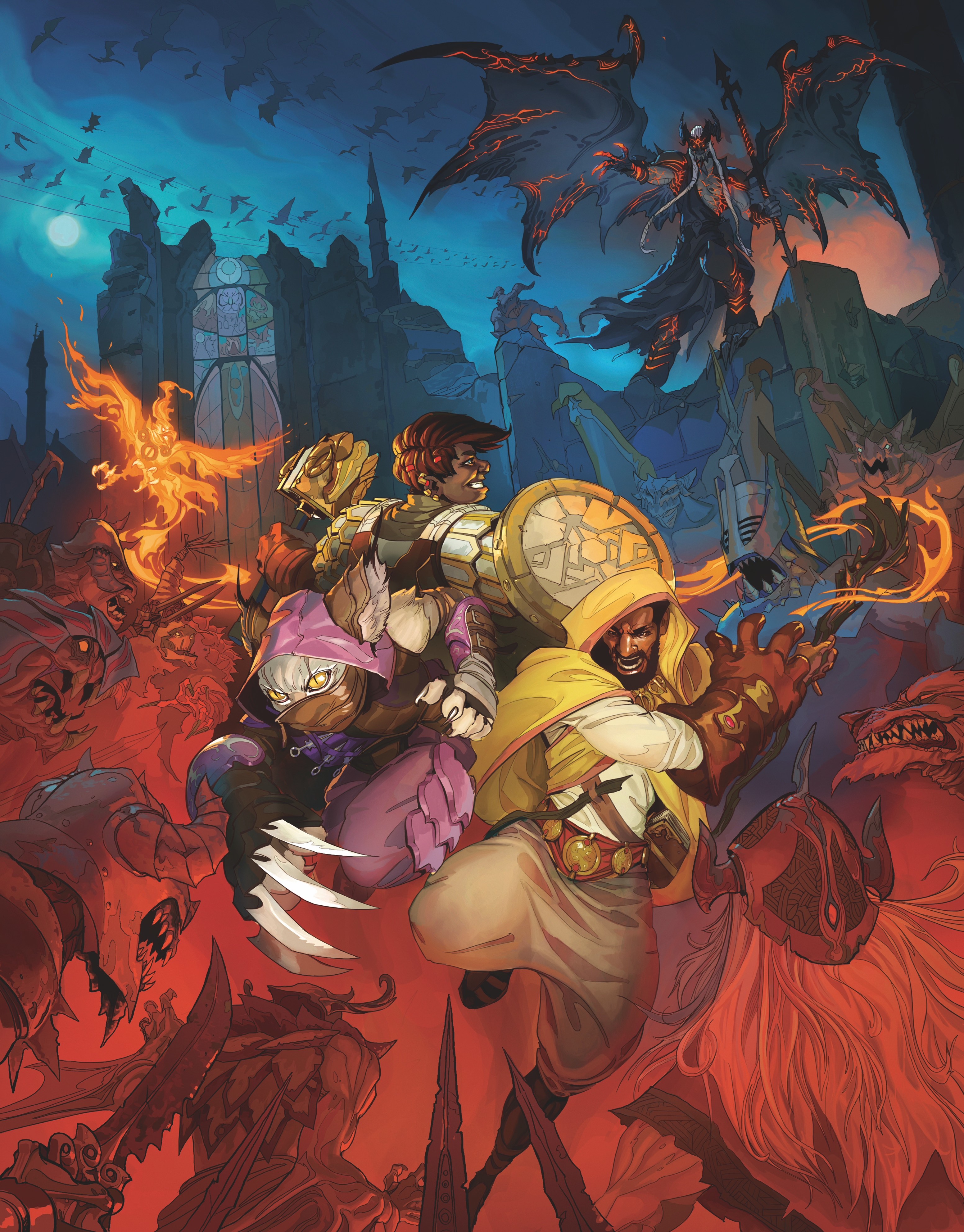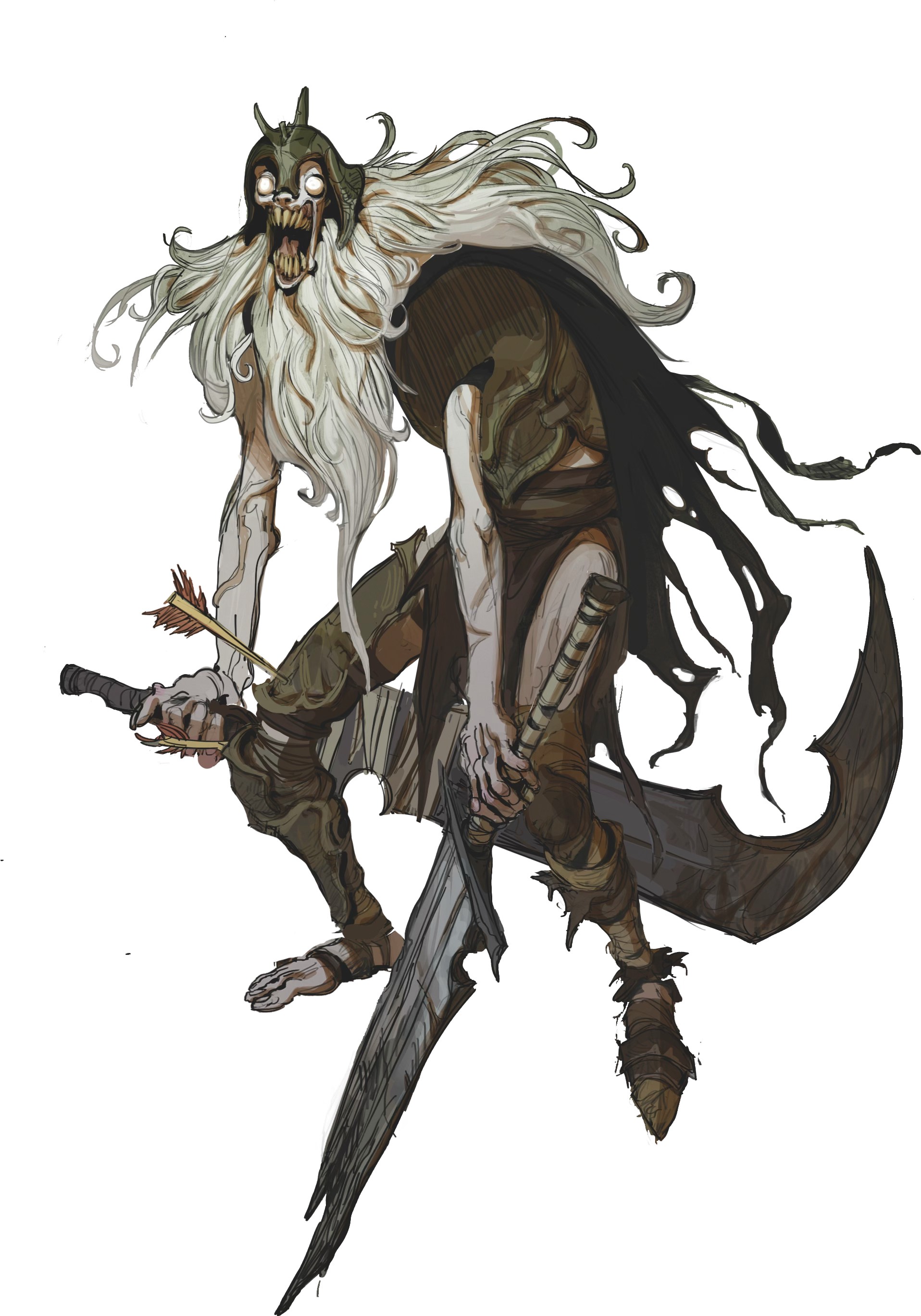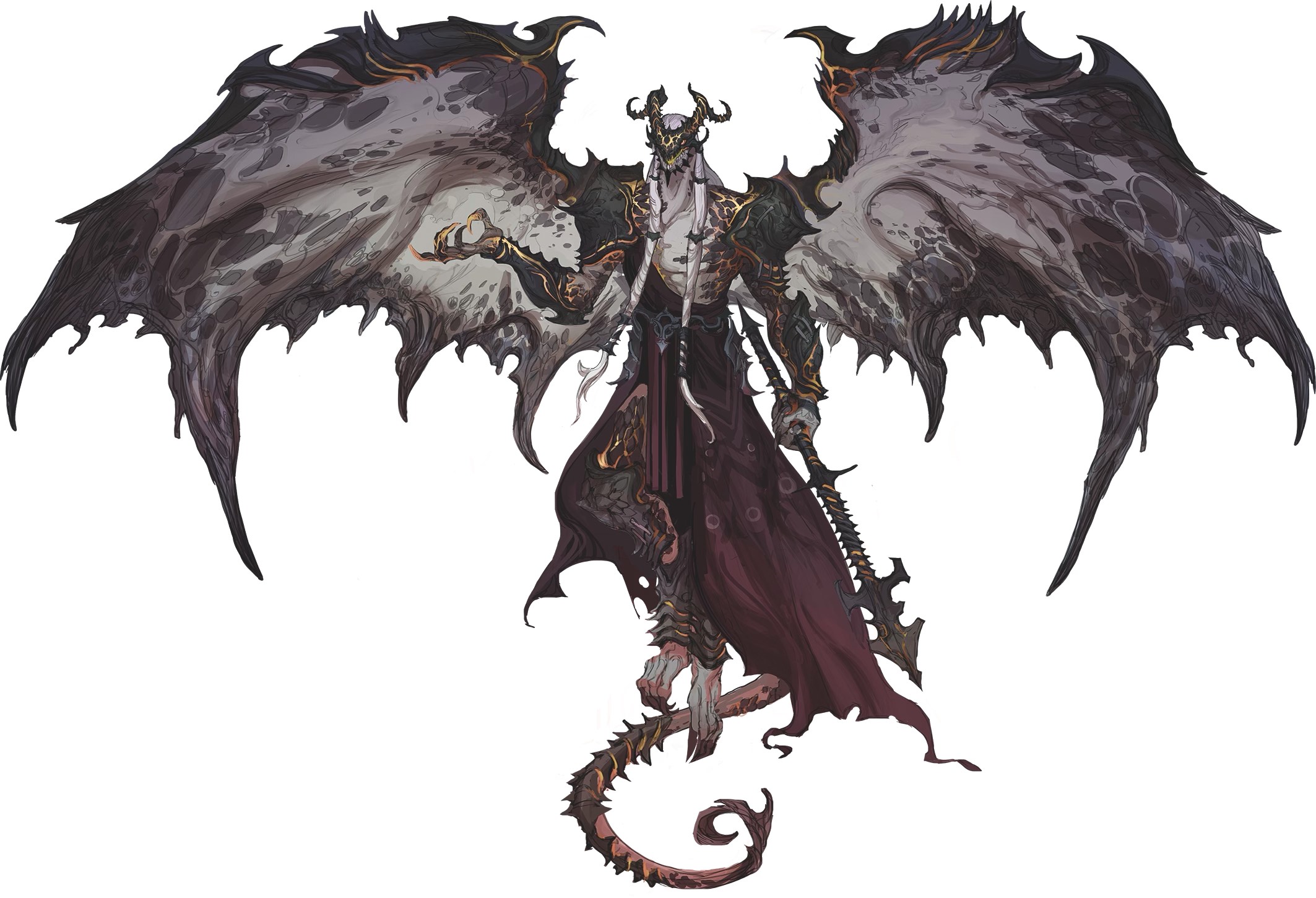06 August 2021
|
Descent: Legends of the Dark answers the question: “how can we make the coolest dungeon crawler ever?”
Read on for an interview with Descent: Legends of the Dark designers about this epic Dungeon Crawl. If you want to see what it looks like inside the box, check out the below video!
“The big question felt like, ‘How can we make the coolest dungeon crawler ever? What can we try to do that we haven’t seen a lot of board games in the genre try before?’,” says Kara Centell-Dunk, one of the designers of the upcoming Descent: Legends of the Dark alongside Nathan Hajek. We’re talking to them today to try and answer that question.
Centell-Dunk is best known for her work on Mansions of Madness Second Edition where she designed all the expansions and DLC scenarios. Hajek is a Descent veteran, having spent the most part of his eight years at Fantasy Flight working on the series – he’s probably best known however for his roles in the Fallout: The Board Game and Journeys in Middle-earth.
For the uninitiated, Descent is maybe one of the first ‘RPG in a box’ experiences to do the name any justice. Minis, maps, and a lot of dungeon crawling fun sit at the centre of the series. The Second Edition is considered something of a masterpiece of turning a crunchy game into something more accessible, and later outings have included the use of app enabled content to guide the story – similar to the excellent Journeys in Middle-earth.
This outing contains the best bits of that formula, with some surprise additions and improvements.
“It’s an epic dungeon crawler board game with a deep, hero-focused story,” says Centell-Dunk, “it’s a board game that leverages having a companion app to do some really exciting things: the app handles storytelling, enemies, and revealing the board, as well as crafting recipes and tracking heroic feats
of the players.”
THE DARKEST DUNGEON
There is a tonal difference too. Players aren’t turning to Descent at this point from a world where dungeon crawling is the norm for fantasy adventures. The changes that the team have made to Legends of the Dark brings it right up to modern, story-centric roleplaying. 
“Our Journeys heroes are often travelling adventurers who get embroiled in a world-ending plot that they don’t necessarily have personal stakes in,” says Centell-Dunk, “in Legends, I think we’re referring to two kinds of legends: both the story of our heroes becoming legends, and the return of legendary foes from Terrinoth’s history. Each hero in legends has a more personal stake in the doom at hand, and we get to explore what that means.”
“In Journeys in the Dark, you play characters who are already legends,” adds Hajek, “they’ve done awesome things, know forbidden knowledge, and have lost limbs before you start. In Legends of the Dark, we wanted to let you take part in that story as they rose up, defining who they are and what makes them a hero.”
“A lot of the design is focused on who the characters are,” continues Hajek, “the skills and weapons of the heroes are specific to them. The majority of quests are cantered around one specific hero at a time. The whole campaign was structured around their journey through a descent into darkness – and most of the mechanics hinge on that aspect.”
Despite this character focus, there’s not a whole load of lore that needs to be ingested before you sit down to play “we include a lore guide in the game to give players a chance to get some background info, but we wrote the story of the game assuming players might not have read that,” says Centell-Dunk. For those who have played previous games, you’re going to see how those characters you’ve previously used before filled out into what they are now.
The opening adventures of the game sees four of the six heroes that you have access to at the start of the game on the road, only to be interrupted in the night by Uthuk (demons who you might recognise from Runewars). As players try and clear up this mess, they uncover a bigger plot that endangers the entire barony.
“The story touches each of our heroes in a different way, and we spend the first part of the game learning more about each hero and how their personal histories,” says Centell-Dunk. The additional two heroes are introduced later in the story, for narrative reasons, as well as being able to build in further complexity to their designs.

TERRINOTH TERRAIN
The central loop of Descent remains the same, you’ll go to locations following a quest, explore them and reveal new rooms as you go. But Legends of the Dark takes us into the third dimension. Now the box comes with a hollowed cavern itself, perfect for storing the 3D terrain of the game.
“Some of my favourite new mechanics in Legends of the Dark are the really physical ones – 3D terrain that creates multilevel maps and card flipping,” says Centell-Dunk, “multilevel maps create these really fun moments—sometimes the floor gives out and your hero literally falls into a mysterious place below. Sometimes you leap off the edge of a building knowing you’ll never be able to return (you can’t move up between levels without stairs), and sometimes enemies are shooting you safely from above while you try and lob arrows back at them or find a way to get up to their level.”
Each hero card, skills and combat card is double sided, which means players will be able to flip their cards to switch between tactics. This makes for fluid responses to situations, and also provides the refresh mechanic. A little like Bloodborne: The Board Game where managing weapon transformations allows your character to carry on.
 “There’s these great moments where you exhaust a skill doing something cool, then flip your card and immediately activate the skill on the back of the card to continue your play,” enthuses Centell-Dunk.
“There’s these great moments where you exhaust a skill doing something cool, then flip your card and immediately activate the skill on the back of the card to continue your play,” enthuses Centell-Dunk.
We asked whether the inclusion of 3D terrain was an attempt to turn players into wargamers.
“I rather came at it the opposite way – I love the terrain of wargames, without really finding a wargame that clicked with me,” says Centell-Dunk, “so I was excited to finally get a game where I could design and play with terrain. When we designed quests I was always asking ‘Can this have more terrain? More levels? How is that integrated into how we play this quest?’”
“It harkens back to HeroQuest for me,” says Hajek, “but of course we’ve ramped it up to 11.”
“By creating multilevel maps we can introduce different gameplay that’s based in verticality, and by including specific terrain we can communicate stuff about how you interact with that terrain in game at a glance,” says Centell-Dunk, “for example, by placing a tree next to a higher tile, players instinctively know they can climb that tree to reach that higher tile.”
“Secondly, there’s the immersion and cool factor. It’s just fun to play with the little furniture and to set it out and make all sorts of different rooms and dungeons. You can make really different feeling maps because the terrain really defines the setting instead of static tile art.”
APPY ADVENTURING
Of course, the app is a real innovation here. While both designers have worked on heavily app-lead games, this is a whole new level of blended play. 
“I spent a lot of time trying to harness as much power from the app as I could without adding additional complexity or distraction,” says Hajek, “because the app always knows which hero is doing what, it can react in a lot of new ways. Enemies can be smarter and the story can be more dynamic.
Leaning into the app also allowed us to do some cool things with weapon parts and trinkets. These have in-app effects that the app executes for you. It can be as simple as applying a status when you attack or as complex bouncing your damage to a second enemy or making the target weak to a new type of damage.
The game does require the app to work – there’s no cardboard work around here – because, as Hajek comments, “it’s my opinion that if a board game has an app that’s not necessary, it either shouldn’t have an app or shouldn’t have a board game.”
Hajek explains that while the app is similar to Journeys In Middle-earth in that it does a lot of record keeping for players, where you are in the round, enemies health and encounters, this was a ground-up rebuild. This means the team were able to introduce extras like a line of sight tool.
A HERO OF ONES OWN
Naturally, we’re going to want to tell our own heroic story with our characters. The six characters in the box come with something like a choose-your-own-upgrade-path built in. Centell-Dunk introduces them for us:
“Brynn’s a human warrior with a noble background, Vaerix is a dragon-hybrid healer with their own complicated history, Chance is a catfolk rogue whose looking for his own way, Syrus is a human wizard who has a unique bond with the phoenix Indris, Galaden is an elf ranger with a vow for vengeance, and Kehli is a dwarf craftsman with a brilliant mind and the deep desire to make her own mark on the world.” 
Each of these heroes has a pair of virtues at the start, which are the seeds of your own narrative tree, “for example, Brynn’s virtues are nobility and valor,” explains Centell-Dunk, “as the story progress, players who choose Brynn are given the choice to have her lean into her role as a noble (nobility), her role as a leading soldier (valor), or to pursue a mixed path between both. Depending on what the players choose, Brynn’s story changes to reflect those choices.”
There’s a huge range of armour, weapons and trinkets to try out through a playthrough also gives you a chance to customise your characters further. Whether you’re building the tank of the party, or the support character that’s going to buff everyone else to legendary levels, the choice is yours.
LEGENDARY MOMENTS
You can’t have an adventure without ‘stand up and punch the air’ moments. That’s why we play these games after all. We ask for the designer’s favourites. 
“As a designer, there’s this really cool quest map that really pushes what the game can do with having multiple levels that unfolds as you play, and another really cool quest where there’s two maps on the table at once and one of them is the world of dreams and what happens there affects the other map. When I played these quests for the first time my jaw dropped,” says Centell-Dunk, “but as a player, it was the first time I used a big synergy to just destroy a certain named enemy. I like to play the wizard, Syrus, and he has a skill card that lets him spend a surge to add successes to his attack for each Phoenix card he has. So, I got all my cards to the right side, another player exposed the enemy for me, and I used a skill to add an extra die to my attack. Everything was riding on rolling a surge, it would be an okay attack without one, but I needed the surge to take the enemy out before it got a chance to attack back during the Darkness phase. And I rolled it! I cackled. It was great. I really dislike that enemy’s personality so finally defeating them, and so spectacularly, felt amazing.”
Hajek provides an airborne answer, “I was playing a test quest where enemies were reinforcing from two sides and I had to essentially capture the flag. So I had Brynn hanging back, attempting to manage the tanky golems while Vaerix dueled with two bandits and a zealot on the other side. Chance hurries up the map, gets the ‘flag,’ then has to get out. So Vaerix and Brynn lead the round clearing the path, using every consumable, weakness, and ounce of fatigue at their disposal.”
“Then using a not-yet spoiled item, Chance glides – yes, glides – down from the tower and slips through the next wave of enemies before they can close in. It was very satisfying to solve the puzzle. Especially because it was a very organic situation. Because the enemies have so much variance and are dynamic, there’s a natural puzzle to solve round to round.”
There’s always going to be a few dangers for designers, and looking after what is a much-loved game is one of them, as Hajek explains, “an underlying question that informed and harried us was the long-term intent of the line. We always wanted multiple boxes of growth for our heroes and story. So not only were we going wide with the quantity and complexity of our systems, but those systems also needed longevity. It’s not an unsolved problem, but it was something that kept popping up.”
“Additionally, because the systems are so vast, a tweak in one system had rippling affects across them all. So it was a long and arduous process of tuning things finer and finer until we found the balanced whole.”
“We’ve got all these cool ways enemies and terrain function in the app that’s so different from other app games even,” says Centell-Dunk, “but trying to forge into all these new areas is challenging because there’s a reason people don’t do multiple levels. There’s both physical consideration and rules consideration when you add verticality to the mix. I’m really, really happy with where we ended up but there were lots of moments where it’s like ‘does this work? No. Okay, how about this one?’”
WHAT’S NEXT?
The sagas of Descent will, of course, continue. While Centell-Dunk will be moving on to other games – and a “top secret project that may never see the light of day”, Hajek remains at the helm. For him, the future of this game is in the app, “the two unique things we can do are continuing the story of our heroes and exploring the ways we can bend the app to our service. There is so much new territory to explore and exploit with the new app system that I’m really looking forward to wowing players over and over with things that have never been done before in board games.”
Interview by Christopher John Eggett
This article originally appeared in issue 57 of Tabletop Gaming. Pick up the latest issue of the UK's fastest-growing gaming magazine in print or digital here or subscribe to make sure you never miss another issue.
Sometimes we may include links to online retailers, from which we might receive a commission if you make a purchase. Affiliate links do not influence editorial coverage and will only be used when covering relevant products








Comments
Login or register to add a comment
No comments